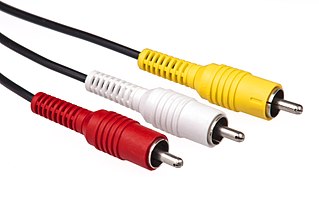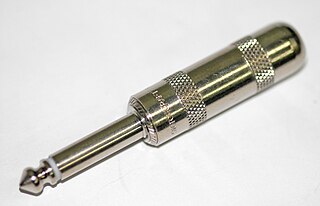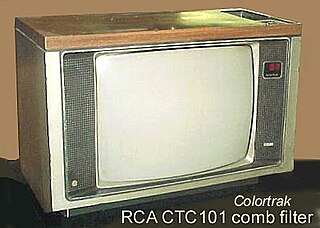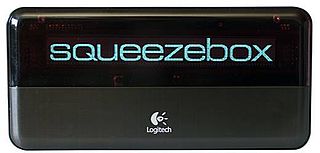This article needs more links to other articles to help integrate it into the encyclopedia .(July 2014) (Learn how and when to remove this template message) |
MultiVision was one of the earliest implementations of PIP (picture-in-picture) television available for purchase by users, pioneered by engineer George Schnurle III and sold by the San Jose, California-based company Multivision Products Inc. [1]
Picture-in-picture (PiP) is a feature of some television receivers and similar devices. One program (channel) is displayed on the full TV screen at the same time as one or more other programs are displayed in inset windows. Sound is usually from the main program only.
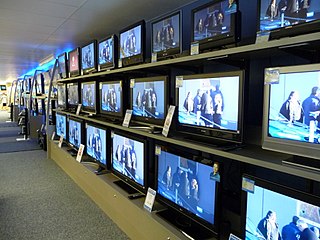
Television (TV), sometimes shortened to tele or telly, is a telecommunication medium used for transmitting moving images in monochrome, or in color, and in two or three dimensions and sound. The term can refer to a television set, a television program, or the medium of television transmission. Television is a mass medium for advertising, entertainment and news.

San Jose, officially the City of San José, is the economic, cultural and political center of Silicon Valley, and the largest city in Northern California. With an estimated 2017 population of 1,035,317, it is the third-most populous city in California and the tenth-most populous in United States. Located in the center of the Santa Clara Valley, on the southern shore of San Francisco Bay, San Jose covers an area of 179.97 square miles (466.1 km2). San Jose is the county seat of Santa Clara County, the most affluent county in California and one of the most affluent counties in the United States. San Jose is the most populous city in both the San Francisco Bay Area and the San Jose-San Francisco-Oakland Combined Statistical Area, which contain 7.7 million and 8.7 million people respectively.
The original MultiVision model was a box that measured 17 inches (43 cm) by 10.5 inches (27 cm) and was 3 inches (7.6 cm) high. It required a VCR to operate and used its own tuner and the VCR to display two television channels. The television antenna was plugged into the MultiVision unit, which was then plugged into the television receiver's antenna input. [2] The program selected on the MultiVision tuner was displayed in a small window inserted into the main TV picture at a position selected by the user. It also functioned as a switching device to connect additional peripherals (such as a laserdisc player) and offered audio outputs to connect external speakers and provide stereo sound. For monaural broadcasts and VHS tapes, the device could provide synthesized stereo audio.

A videocassette recorder, VCR, or video recorder is an electromechanical device that records analog audio and analog video from broadcast television or other source on a removable, magnetic tape videocassette, and can play back the recording. Use of a VCR to record a television program to play back at a more convenient time is commonly referred to as timeshifting. VCRs can also play back prerecorded tapes. In the 1980s and 1990s, prerecorded videotapes were widely available for purchase and rental, and blank tapes were sold to make recordings.
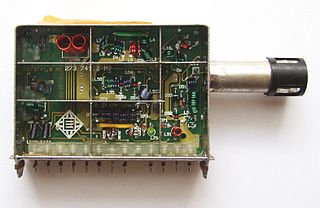
A tuner is a subsystem that receives radio frequency (RF) transmissions like radio broadcasts and converts the selected carrier frequency and its associated bandwidth into a fixed frequency that is suitable for further processing, usually because a lower frequency is used on the output. Broadcast FM/AM transmissions usually feed this intermediate frequency (IF) directly into a demodulator that convert the radio signal into audio-frequency signals that can be fed into an amplifier to drive a loudspeaker.

VHS is a standard for consumer-level analog video recording on tape cassettes. Developed by Victor Company of Japan (JVC) in the early 1970s, it was released in Japan on September 9, 1976 and in the United States on August 23, 1977.

The MultiVision 3.1 model was an unusually shaped device, similar in size to the original, that lacked any form of controls on the device itself. It used its own two tuners and/or a VCR and/or other devices to display two video sources at once. The tunerless MultiVision 1.1 model looked virtually identical to the 3.1 except in rear view, and featured 4 composite, plus left and right audio input sets, plus switchable external audio and video processor loops. Both provided composite and left and right audio outputs for TV input.
On the 1.1 and 3.1 models, the audio could be set in sync to either the main source or the PIP or selected independently. The 1.1 model's remote had 12 color-coded buttons, 4 each for the main picture, PIP picture, and audio, and like the 3.1's remote included other buttons for swapping main and inset picture, PIP on/off, PIP size, PIP position, audio sync on or off, mute, and more. Their remotes featured angled output ends, which facilitated accurate button selection whilst reclined.



